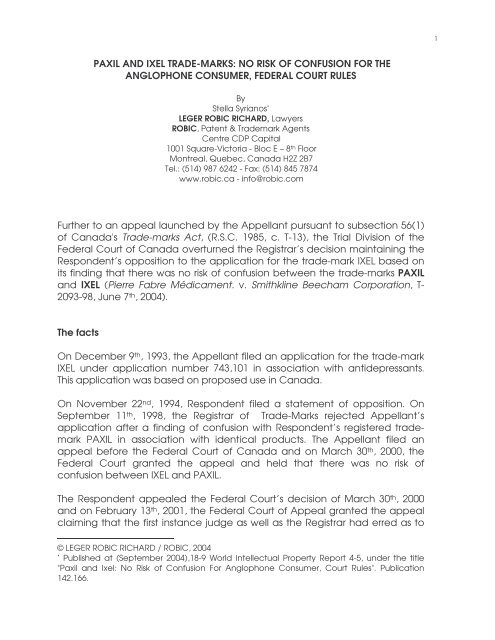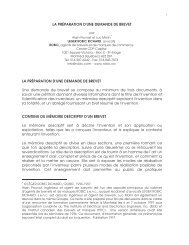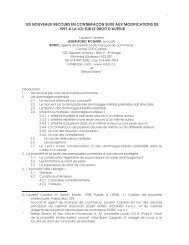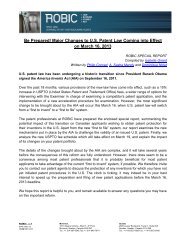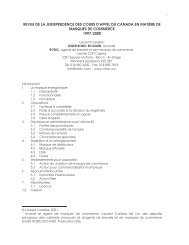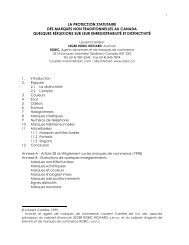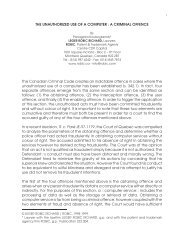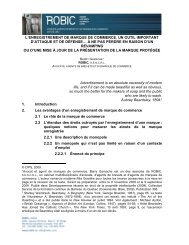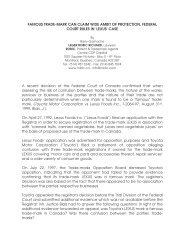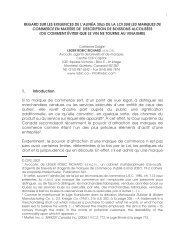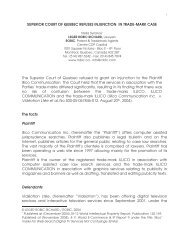PAXIL AND IXEL TRADE-MARKS - Léger Robic Richard
PAXIL AND IXEL TRADE-MARKS - Léger Robic Richard
PAXIL AND IXEL TRADE-MARKS - Léger Robic Richard
Create successful ePaper yourself
Turn your PDF publications into a flip-book with our unique Google optimized e-Paper software.
1<br />
<strong>PAXIL</strong> <strong>AND</strong> <strong>IXEL</strong> <strong>TRADE</strong>-<strong>MARKS</strong>: NO RISK OF CONFUSION FOR THE<br />
ANGLOPHONE CONSUMER, FEDERAL COURT RULES<br />
By<br />
Stella Syrianos *<br />
LEGER ROBIC RICHARD, Lawyers<br />
ROBIC, Patent & Trademark Agents<br />
Centre CDP Capital<br />
1001 Square-Victoria - Bloc E – 8 th Floor<br />
Montreal, Quebec, Canada H2Z 2B7<br />
Tel.: (514) 987 6242 - Fax: (514) 845 7874<br />
www.robic.ca - info@robic.com<br />
Further to an appeal launched by the Appellant pursuant to subsection 56(1)<br />
of Canada's Trade-marks Act, (R.S.C. 1985, c. T-13), the Trial Division of the<br />
Federal Court of Canada overturned the Registrar’s decision maintaining the<br />
Respondent’s opposition to the application for the trade-mark <strong>IXEL</strong> based on<br />
its finding that there was no risk of confusion between the trade-marks <strong>PAXIL</strong><br />
and <strong>IXEL</strong> (Pierre Fabre Médicament. v. Smithkline Beecham Corporation, T-<br />
2093-98, June 7 th , 2004).<br />
The facts<br />
On December 9 th , 1993, the Appellant filed an application for the trade-mark<br />
<strong>IXEL</strong> under application number 743,101 in association with antidepressants.<br />
This application was based on proposed use in Canada.<br />
On November 22 nd , 1994, Respondent filed a statement of opposition. On<br />
September 11 th , 1998, the Registrar of Trade-Marks rejected Appellant’s<br />
application after a finding of confusion with Respondent’s registered trademark<br />
<strong>PAXIL</strong> in association with identical products. The Appellant filed an<br />
appeal before the Federal Court of Canada and on March 30 th , 2000, the<br />
Federal Court granted the appeal and held that there was no risk of<br />
confusion between <strong>IXEL</strong> and <strong>PAXIL</strong>.<br />
The Respondent appealed the Federal Court’s decision of March 30 th , 2000<br />
and on February 13 th , 2001, the Federal Court of Appeal granted the appeal<br />
claiming that the first instance judge as well as the Registrar had erred as to<br />
<br />
© LEGER ROBIC RICHARD / ROBIC, 2004<br />
* Published at (September 2004),18-9 World Intellectual Property Report 4-5, under the title<br />
"Paxil and Ixel: No Risk of Confusion For Anglophone Consumer, Court Rules". Publication<br />
142.166.
2<br />
the applicable test for confusion and proceeded to remit the matter to the<br />
Trial Division for determination on the merits.<br />
Federal Court Trial Division Decision (de novo)<br />
The Trial Division determined that the issue at bar was the following: on the<br />
balance of probabilities, would the average anglophone consumer with<br />
imperfect recollection and based on first impressions, be confused between<br />
the marks <strong>IXEL</strong> and <strong>PAXIL</strong> ?<br />
In assessing the risk of confusion in accordance with the criteria enumerated<br />
in section 6 of the Trade-marks Act, the Court made the following findings:<br />
(i) the inherent distinctive character of the marks<br />
Both the marks <strong>IXEL</strong> and <strong>PAXIL</strong> are unique and invented words that are<br />
uncommon and as such this element favored neither party.<br />
(ii) length of time marks used and extent to which they have become<br />
known<br />
Despite Respondent’s evidence that since 1997 the <strong>PAXIL</strong> product was the<br />
best selling antidepressant in Canada, the Court held that there was no<br />
evidence of use of the <strong>PAXIL</strong> trade-mark which accrued to Respondent (no<br />
proof of Respondent’s direct or indirect control of the quality or characteristic<br />
of the product was furnished). Consequently, this element could not favor the<br />
Respondent.<br />
(iii) nature of the products<br />
The marks were associated to identical products, i.e. antidepressants and<br />
therefore the likelihood of confusion increased; a factor that clearly favored<br />
the Respondent.<br />
(iv) nature of the trades<br />
Both of the parties’ antidepressants were sold in the same manner, i.e. under<br />
prescription from a doctor and subsequently purchased from a pharmacist.<br />
The Court opined that even though the nature of the parties’ trade was<br />
identical, the risk of confusion was reduced since these products are<br />
provided by professionals who are accustomed to meticulously exercising<br />
care in distinguishing between the names of different products. As such, this<br />
element favored the Appellant.<br />
(v) degree of resemblance between the marks<br />
With regards to the ideas suggested by the trade-marks, the Court held that<br />
no confusion ensued since both marks were distinctive and were not
3<br />
suggestive of any particular meaning in either the French or English<br />
languages.<br />
As for the appearance of the marks at issue, the parties had agreed that for<br />
the average francophone consumer, there was no likelihood of confusion.<br />
The Court then turned to the issue of determining the likelihood of confusion<br />
based on the phonetic similarity of the trade-marks (for the average<br />
anglophone consumer) for which linguistic expert evidence was adduced.<br />
Expert evidence<br />
Both the Appellant and Respondent relied on the testimony of their<br />
respective linguistic experts. The Respondent’s expert opined that the<br />
majority of anglophones would pronounce the second syllables of the marks<br />
in an identical manner, thus resulting in confusion. The Appellant’s expert<br />
argued that the first syllables of the marks were of greater importance and<br />
that the letter “P” in Respondent’s <strong>PAXIL</strong> mark provided for a unique and<br />
entirely different pronunciation from the letter “I” in Appellant’s <strong>IXEL</strong> mark.<br />
The Court held that the Respondent’s expert witness’ testimony lacked<br />
objectivity in that no analysis was made as to the impact regarding the<br />
differences in the first syllables of the marks. On the other hand, the Court<br />
accorded greater probative value to the Appellant’s expert evidence and<br />
agreed that the first syllable was more important than the second syllable.<br />
Consequently, the Court decided that on a phonetic level there was no risk of<br />
confusion between the marks at issue for the average anglophone consumer.<br />
It is interesting to note the Court mentioned that linguistic expert evidence is<br />
of limited value in that it does not take into consideration other factors<br />
required in assessing the risk of confusion. For instance, the Court stated that<br />
psychological factors (rather than linguistic ones) such as first impressions and<br />
imperfect recollection were not elements considered by the linguistic experts.<br />
Conclusion<br />
Based on the above elements, the Court concluded that the nature of the<br />
parties’ trade, that is, prescription drugs, coupled with the small degree of<br />
resemblance between the marks, lent support to the Appellant’s argument<br />
of non-confusion. As such, the Court rejected Respondent’s opposition and<br />
ordered the Registrar to allow the Appellant’s mark to registration.<br />
This case serves as a reminder to trade-mark practitioners that while the<br />
assessment regarding the risk of confusion between marks can be made in<br />
the context of the average bilingual consumer, consideration must be given<br />
to the unilingal consumer be it in the English or French languages.
5<br />
ROBIC, un groupe d'avocats et d'agents de brevets et de marques de commerce voué<br />
depuis 1892 à la protection et à la valorisation de la propriété intellectuelle dans tous les<br />
domaines: brevets, dessins industriels et modèles utilitaires; marques de commerce, marques<br />
de certification et appellations d'origine; droits d'auteur, propriété littéraire et artistique, droits<br />
voisins et de l'artiste interprète; informatique, logiciels et circuits intégrés; biotechnologies,<br />
pharmaceutiques et obtentions végétales; secrets de commerce, know-how et<br />
concurrence; licences, franchises et transferts de technologies; commerce électronique,<br />
distribution et droit des affaires; marquage, publicité et étiquetage; poursuite, litige et<br />
arbitrage; vérification diligente et audit; et ce, tant au Canada qu'ailleurs dans le monde. La<br />
maîtrise des intangibles.<br />
ROBIC, a group of lawyers and of patent and trademark agents dedicated since 1892 to the<br />
protection and the valorization of all fields of intellectual property: patents, industrial designs<br />
and utility patents; trademarks, certification marks and indications of origin; copyright and<br />
entertainment law, artists and performers, neighbouring rights; computer, software and<br />
integrated circuits; biotechnologies, pharmaceuticals and plant breeders; trade secrets,<br />
know-how, competition and anti-trust; licensing, franchising and technology transfers; e-<br />
commerce, distribution and business law; marketing, publicity and labelling; prosecution<br />
litigation and arbitration; due diligence; in Canada and throughout the world. Ideas live<br />
here.<br />
COPYRIGHTER<br />
IDEAS LIVE HERE<br />
IL A TOUT DE MÊME FALLU L'INVENTER!<br />
LA MAÎTRISE DES INTANGIBLES<br />
LEGER ROBIC RICHARD<br />
NOS FENÊTRES GR<strong>AND</strong>ES OUVERTES SUR LE MONDE DES AFFAIRES<br />
PATENTER<br />
R<br />
ROBIC<br />
ROBIC + DROIT +AFFAIRES +SCIENCES +ARTS<br />
ROBIC ++++<br />
ROBIC +LAW +BUSINESS +SCIENCE +ART<br />
THE <strong>TRADE</strong>MARKER GROUP<br />
<strong>TRADE</strong>MARKER<br />
VOS IDÉES À LA PORTÉE DU MONDE , DES AFFAIRES À LA GR<strong>AND</strong>EUR DE LA PLANÈTE<br />
YOUR BUSINESS IS THE WORLD OF IDEAS; OUR BUSINESS BRINGS YOUR IDEAS TO THE WORLD


